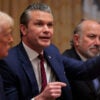
On President Obama’s trip across Asia, the major news has not been America’s policy posture, but rather our president’s personal posture. On Saturday, photo and video emerged of President Obama bowing at a 45 degree angle, head down, hand outstretched to Japan’s Emperor Akihito. Even within Japanese culture, this bow was certainly excessive. And the flood of pictures now surfacing of other world leaders greeting the Emperor without so much as a head nod prove that this bow was more than a simple diplomatic gesture.
The bow certainly plays into the image that President Obama is overly obsequious during his overseas trips, such as repeatedly making apologies for past US actions and policies. But more importantly, it reflects the Obama strategy of distinguishing his administration from President Bush’s by making improving the US image the major policy objective rather than as a means to an ends. In fact, he is at such pains to demonstrate respect in relationships where respect and engagement were already abundant, that he can only demonstrate the difference with Bush by going over the top.
Several other questions come to mind after seeing the bow several times.
Does the president understand the difference between a bow and a kowtow? The Japanese media certainly do. They did not distribute the embarrassing photo of the president and the emperor to the Japanese people. Instead they chose to distribute the more conservative greeting shared between the President and the Emperor’s wife. The Japanese know the bow would demonstrate weakness on behalf of President Obama, and neither Japan nor the United States would benefit from this impression.
Who coached the president on the proper way to greet the emperor—a State Department employee, a National Security Council aide, his social secretary? Whoever it was, they were not serving the interests of the President or the nation. Proper, social and diplomatic etiquette is demanded upon any U.S. president, but gestures such as this greeting should not tell more about a meeting rather than the policy that leaves it. Or did the President take it entirely upon himself to discern the complexities of Japanese social custom and the impact on international public perceptions?
Why does the president seem to apologize for America to every foreign leader he meets? President Obama’s reverential bow to Emperor Akihito raises yet again questions as to whether the president understands that he swore an oath to uphold the U.S. Constitution, not the UN Charter, and to preserve and protect U.S. interests, not the self-interests of other nations.
At first the idea of an Obama ‘apology tour’ seemed far fetched. But when Air Force One touches down anywhere overseas, President Obama seems determined to demonstrate he is not President Bush or any other president and that America is humbled by other nation’s leadership.
Asian leaders pay careful attention to the conduct of a visiting dignitary. President Obama’s obsequious act was that of a third world official – if that – not the chief of state of the most important nation in the world. While President Obama’s diplomatic inexperience can excuse some behavior, ten months into his presidency, he and his staff should know better.
President Obama’s bow, almost a kowtow, to Japan’s emperor is more than embarrassing. But most importantly it detracts from the more important aspects of the president’s trip to Asia. The President has rightly affirmed a strong stance towards North Korea and made strides in a couple other critical ongoing policy matters, many left over from President Bush’s near decade of engagement. On the negative side of the ledger, Obama has demonstrated a total lack of U.S. trade policy, ignoring pleas for progress on trade issues and drawing criticism from both sides of the Pacific.
But those issues will be put aside while America and the rest of the world guess what President Obama meant by his extreme bow. Presidents from Nixon to Clinton to Bush were able to greet Japanese leaders with the proper mix of respect and decorum. Those photos of past presidents are available to review but often forgotten. The image of Obama bowing is a picture worth a thousand words, and will be an image embedded in the minds of historians when they reflect on his administration.




























42 Replies to “Obama in Japan: Not a Bow but a Kowtow”